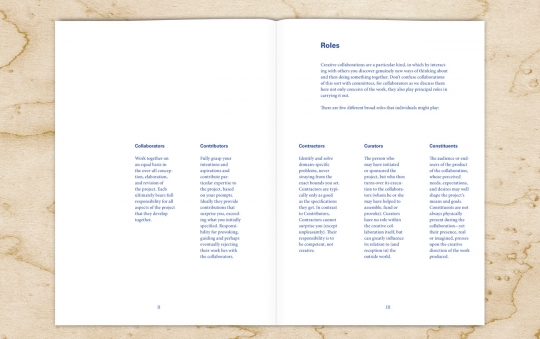At any given moment we're working on things ranging from helping the city of Helsinki develop new service modalities for child care, to proposing a model for low carbon development, to rethinking the way governments interact with citizens—but one thing that's consistent across every project, regardless of content, is the need to collaborate. Simply put, we do almost nothing alone. Today I'm happy to announce that Sitra has published Creative Collaborations, a practical guide for working together, written by OpenEndedGroup (more on them in a second).
You can download a copy here.
By creative collaborations we mean work that, in the words of the authors:
— Follows no leader: Collaborators interact with each other on an equal basis. They engage in a freewheeling dialogue whose process and outcome remain open-ended until they come to a shared conclusion.
— Aim at invention: Collaborators occupy themselves with exploring diverse, far-flung, and even contradictory ideas, keeping at it for as long as required to alight upon a good and novel solution.
Participating in efforts such as this can be awkward, or even difficult, if one is not used to it. There's a rhythm to working together in this way and it's something that one usually needs to grow into, something that one has to practice.
More often than not we are introducing our collaborators to multidisciplinary work and for that reason we found ourselves wanting to have a guide that we could offer. Something that gives people an idea of what they might expect when being part of a creative collaboration.
To help us with this, we commissioned Marc Downie, Shelley Eshkar, and Paul Kaiser, who together comprise the OpenEndedGroup. They've honed the practice of working with others during decades of multidisciplinary arts projects, collaborating with artists such as Merce Cunningham, Bill T. Jones, and Robert Wilson as well with as with conductors, musicians, lighting designers, architects, scientists, engineers, and scholars.
The OpenEndedGroup drafted a text that proposes five roles (Collaborator, Contributor, Contractor, Curator, Constituents) and then 19 rules of thumb for collaborators. The result is a slim booklet that reads easily and quickly. I would have loved to have had this before the Studios we did in 2010 and 2011, for instance. It will be a valuable resource for future studios and other projects.
Sharing this today is part of our continued effort to maintain a legible practice. That is, to invest part of our time in describing how we do our work—how we practice design—in hopes that it will help us learn from our peers.
And because we believe in making everything we do public, we're offering the booklet for free download under a Creative Commons license. If you're the sort who likes to read on paper, you can also get a copy via print on demand service Lulu.com.
Doing the graphic design for the the booklet was one of my summer projects, and itself a collaboration with lots of back and forth between OpenEndedGroup and us as we collectively tweaked the format and the content.

A pile of layout dummies testing different covers and interiors.

For a brief phase the booklet featured narrative typography, which worked OK on a spread like this, but was difficult to resolve on pages with content that did not lend itself directly to typographic representations.

Who knew a table of contents could go through so many revisions?
Many thanks to Marc, Shelley, and Paul for their clear and concise writing. Download a copy and see if you enjoy it as much as we did.
I'll end this post with a request. On our Design Ethnography Field Guide download page we have listed alternative sources in case people want to see similar resources. If you have other resources which are useful guides for collaborative work please leave a message in the comments or let us know via @HDL2010 on Twitter so we can build a pool of resources around this topic as well.








